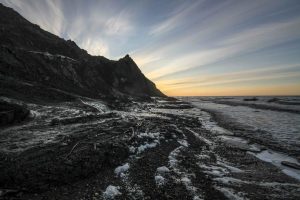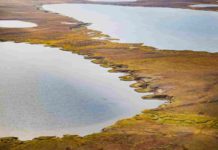
The thawing and erosion of Arctic permafrost coasts has dramatically increased in the past years and the sea is now consuming more than 20 metres of land per year at some locations. The earth masses removed in this process increasingly blur the shallow water areas and release nutrients and pollutants. Yet, the consequences of these processes on life in the coastal zone and on traditional fishing grounds are virtually unknown. Scientists from the Alfred Wegener Institute, Helmholtz Centre for Polar and Marine Research (AWI) urge to focus our attention on the ecological consequences of coastal erosion in the January issue of the journal Nature Climate Change. According to the scientists, an interdisciplinary research program is required, and must involve policy-makers as well as inhabitants of the Arctic coasts right from the onset.
The difference could hardly be greater. In the winter, when the Beaufort Sea is frozen around the Canadian permafrost island of Herschel Island (Qikiqtaruk), the sea water in the sample bottles of the AWI researcher Dr Michael Fritz looks crystal clear. In summer, however, when the ice floes are melted and the sun and waves start to wear the cliff away, the water sample of the Potsdam geoscientist contains a cloudy broth.
“Herschel Island loses up to 22 metres of coast each year. The thawed permafrost slides down into the sea in the form of mud slides and blurs the surrounding shallow water areas so much that the brownish-grey sediment plumes reach many kilometres into the sea,” reports the polar researcher.
His observations of Herschel Island can now be transferred to large parts of the Arctic. 34 percent of the coasts around the world are permafrost coasts. This means, especially in the Arctic, that its soil contains a large amount of frozen water, which keeps the sediments together like cement. If the permafrost thaws, the binding effect fails. The sediments as well as animal and plant remains, which are frozen in the permafrost, are suddenly released in the water and are washed away by the waves.
In this process, greenhouse gases such as carbon dioxide and methane are released and lead to even greater global warming. The eroded material also contains a lot of nutrients and pollutants such as nitrogen, phosphorus or mercury. These substances enter the sea, where they are further transported, degraded or accumulated and permanently alter the living conditions in the shallow water area. “We can until now only guess the implications for the food chain. To date, almost no research has been carried out on the link between the biogeochemistry of the coastal zone and increasing erosion and what consequences this has on ecosystems, on traditional fishing grounds, and thus also on the people of the Arctic,” says Michael Fritz.
For this reason, Michael Fritz, the Dutch permafrost expert Jorien Vonk and AWI researcher Hugues Lantuit call on the polar research community to systematically investigate the consequences of coastal erosion for the arctic shallow water areas in the current issue of the journal Nature Climate Change. “The processes in the arctic coastal zone play an outstanding role for four reasons. Firstly, the thawed organic material is decomposed by microorganisms, producing greenhouse gases. Secondly, released nutrients stimulate the growth of algae, which can lead to the formation of low-oxygen zones. Thirdly, the addition of organic carbon increases the acidification of the sea, and fourth, the sediments are deposited on the seabed or are transported to the open ocean. This has direct consequences for the biology of the sea,” the authors say.
The urgency of the topic also increases with the warming of the Arctic: “We believe that the erosion of the Arctic coasts will increase drastically as a result of rising temperatures, the shrinking of the protective sea ice cover, and the rising sea level,” says AWI permafrost expert and co-author Professor Hugues Lantuit. He adds that “during the ice-free season the waves can hit the coast higher and affect more land.” An erosion of that magnitude will without a doubt alter the food web in the coastal zone, and will affect those people who depend on fishing and who cultivate their traditional way of life along Arctic coasts.
The main reason why research on this topic has not been carried out so far is linked to logistics. Much of the arctic coastal and shallow water zones are not accessible either by car or plane, or by large icebreakers. There is also no arctic-wide station network at the coast that could be used by researchers to collect reliable data. “Politics and science must find common solutions here, for example within the framework of the EU research program Horizon 2020. In order to make concrete statements on the consequences of erosion, we need an interdisciplinary research program that includes policy-makers and the Arctic population from the beginning,” says Michael Fritz.
Reference:
Michael Fritz, Jorien E. Vonk, Hugues Lantuit. Collapsing Arctic coastlines. Nature Climate Change, 2017; 7 (1): 6 DOI: 10.1038/nclimate3188
Note: The above post is reprinted from materials provided by Alfred Wegener Institute, Helmholtz Centre for Polar and Marine Research.










